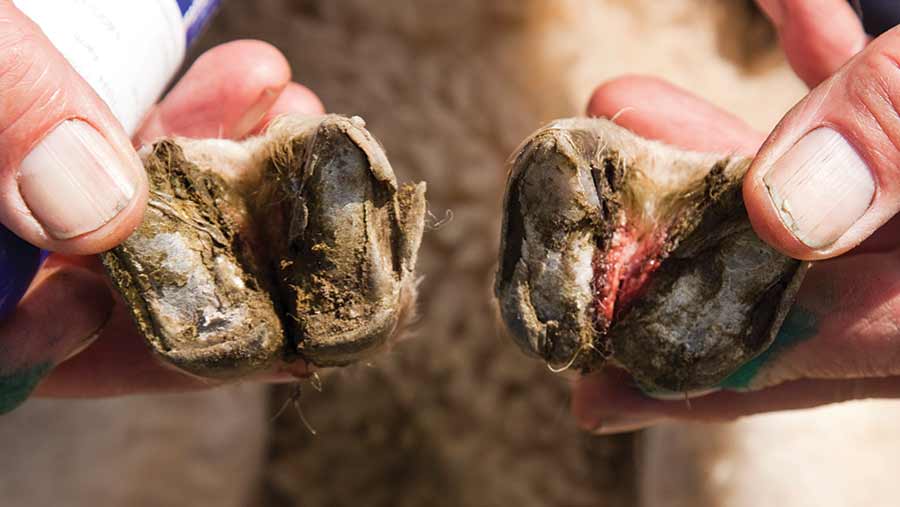Q&A: How to tackle scald in sheep
Scald is the most common cause of lameness of lambs and can lead to footrot. It is a perpetual threat to sheep flock lameness levels, health and welfare and ultimately productivity.
It is the most common cause of lameness in lambs, and not uncommon in adult sheep.
What causes scald?
It is caused by opportunistic bacteria that damage the soft tissue between the toes.
 Emily Gascoigne
Emily GascoigneXLVets Synergy Farm Health
Risk factors include high stocking density, grazing long grass, moist conditions (either at housing or at grazing) and common collecting points such as increased time around gates, trees or feed stations.
What are the symptoms?
Scald often presents in lambs with very sudden-onset lameness. When examined, animals have inflamed tissue between the toes and a distinctive smell in a similar way to footrot. It can be very difficult to differentiate this from early footrot.
See also: How one flock has reduced lameness using the five-point plan
Pain and inflammation associated with scald sometimes renders sheep non-weight bearing, which will increase lying time, thus reducing daily liveweight gains.
How can you treat it?
While scald in its most simple form is easily treated with antibiotic oxytetracycline spray, it is now recognised that it is a predisposing presentation for footrot, caused by Dichelobacter nodosus.
Although unresolved, the suggestion is that some cases of scald go on to become footrot when left untreated. This happens when a particularly virulent strain of D nodosus is the cause, or when individual animals are susceptible. Therefore, scald management and reduction is an essential part of whole-flock lameness reduction.
How can scald be prevented?
Scald can affect up to 40% of animals in a group, so controls are often needed for the whole management group. Foot-bathing can be an effective method of whole-group treatment, but its efficacy depends on:
(a) Identifying the risk factor(s) so they can be reduced or avoided after foot-bathing and
(b) Foot-bathing in an effective manner (see “How to foot-bathe effectively”).
Ideally animals should be moved on to clean grazing. This is pasture that has been free from sheep for two to three weeks (after foot-bathing) to reduce re-exposure to footrot. It should also, if possible, be away from long grass.
Collecting points can be treated with topical products such as powdered lime. Alternatively, feeders should be moved more regularly to avoid the build-up of pathogens.
How to foot-bathe effectively
The manner in which sheep are foot-bathed is incredibly important for efficacy.
The foot-bath should be cited somewhere dry, ideally with concrete before entry and after exit.
- Ensure the chemical is at the correct dilution rate.
- The foot-bath should not become contaminated by dirty feet. Run sheep through a water foot-bath before the bath with active ingredient, or hose feet off.
- Ensure animals are in it for long enough (read the product guidelines).
- Stand sheep on concrete after bathing for about 20 minutes until the product dries.
Foot-bathing without inspection may also mean that animals needing antibiotics – for example, those with footrot – may be missed.
This will enable them to propagate footrot to other animals. With footrot, a break occurs at the skin horn junction. Infection then spreads under the horn tissue, so the wall of the hoof becomes separated and the sole underrun.
Five-point plan
The Farm Animal Welfare Council’s objective is to reduce national lameness level to less than 2% by 2021. The golden rules of footrot management apply to scald control using the five-point plan:
- Build resilience within a flock
- Cull animals
- Genetic selection
- Reduce disease challenge
- Avoid high-risk behaviours that increase risk of infection – for example, bringing animals into close contact
- Treat affected animals promptly to reduce spread of infection and to improve their own health and welfare
- Quarantine incoming animals to reduce risk of introducing animals with a more virulent strain of footrot/contagious ovine digital dermatitis
- Establish immunity
- Vaccinating may be helpful when there is a high prevalence of concurrent footrot.

